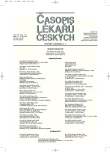Review of patients with musculoskeletal injury treated during winter months in a highland hospital
Authors:
M. Rousek Jr. 1; M. Rousek 2
; V. Džupa 3
Authors‘ workplace:
Univerzita Karlova v Praze, 3. lékařská fakulta
1; Oblastní nemocnice Trutnov a. s., Chirurgické oddělení
2; Univerzita Karlova v Praze, 3. lékařská fakulta a FNKV, Ortopedicko-traumatologická klinika
3
Published in:
Čas. Lék. čes. 2009; 148: 303-308
Category:
Original Article
Overview
Background.
The authors examined the incidence of musculoskeletal injuries according to their type and location in the period of winter at a highland hospital, which also functions as a regional hospital for a few winter sport resorts.
Methods and results.
In the sample there were 1644 patients (696 women, 948 men) treated for primary musculoskeletal injuries from 1. 1. to 31. 3. 2008. This was a retrospective study; the data were collected from medical reports. It included: age, sex, mechanism of injury, diagnosis and whether the patient had to be hospitalised or not.
Age of the patients ranged from 1 to 95 years with an average of 29 years (31 for women and 28 for men). Younger age groups dominated among men. After 70 years of age there was a prevalence of women. Fractures were the most common cause of injury (653, 39.7%), followed by injuries to the joints‘ ligamentary apparatus by mechanism of distortion (379, 23.1%). Next in incidence were soft tissue injuries caused by contusion (325, 19.7%) and open wounds (241, 14.7%). The least common were luxated joints (43, 2.6%) and closed injury to muscles and tendons (3, 0.1%). The most frequent site of injury was the hand (404, 24.6%), while the least frequent place was the thigh (17, 1.0%).
Conclusions.
In conclusion the study confirmed that other than the age, gender and the season, the geographic location also influences the spectrum of musculoskeletal injuries. The study also showed that the most common type of injuries was that of the upper extremity. The study did not confirm the expected prevalence of fractures among women. The prevalence of men was probably because of the prevalence of winter sport activities as a leading cause of injury (mostly skiing and snowboarding).
Key words:
musculoskeletal injuries, incidence, epidemiology, ski and snowboard injuries
Sources
1. Baron JA, Karagas M, Barrett J, Kniffin W, Malenka D, Mayor M, Keller RB. Basic epidemiology of fractures of the upper and lower limb among Americans over 65 years of age. Epidemiology 1966; 7: 612–618.
2. Čelko AM. Epidemiologie pádů seniorů v České republice. In: Benešová, V. et al.: Úrazy seniorů a možnosti jejich prevence. 1. vyd. Praha: CÚP UK 2. LF a FN Motol 2003; 29–32.
3. Jonsson BY, Siggeirsdottir K, Mogensen B, Sigvaldason H, Sigurdsson G. Fracture rate in a population-based sample of men in Reykjavik. Acta Orthop. Scand 2004; 75: 195–200.
4. Kanis JA. The incidence of hip fracture in Europe. Osteoporos. Int, 1993; 3 (Suppl 1): S10–S15.
5. Lohiya H-S, Crinella FM, Tan-Figueroa L, Caires S, Lohiya S. Fracture epidemiology and control in a developmental center. West J Med 1999; 170: 203–209.
6. Prince RL, Knuiman MW, Gulland L. Fracture prevalence in an Australian population. Aust J Public Health 1993; 17: 124–128.
7. Škapinec P, Tislický J, Džupa V, Procházka B. Přehled úrazových diagnóz pacientů ošetřených na traumatologické ambulanci v zimních měsících. Osteol Bull 2005; 10: 27–32.
8. Tislický J, Škapinec P, Džupa V, Procházka B. Časová distribuce vzniku nejčastějších poranění pohybového aparátu. Uraz Chir 2006; 14: 60–65.
9. Balk R, Hahn F, Tarcea B. Die proximale Femurfraktur. Häufigkeit, Demographie, Etiologie, Prophylaxe. OP-Journal 2002; 17: 80–84.
10. Cuenca J, Martínez AA, Herrera A, Domingo J. The incidence of distal forearm fractures in Zaragoza (Spain). Chir Main 2003; 22: 211–215.
11. Chung KC, Spilson SV. The frequency and epidemiology of hand and forearm fractures in the United States. J Hand Surg 2001; 26-A: 908–915.
12. Black DM, Cooper C. Epidemiology of fractures and assessment of fracture risk. Clin Lab Med 2000; 20: 439–453.
13. van Staa TP, Dennieson EM, Leufkens HG, Cooper C. Epidemiology of fractures in England and Wales. Bone 2001; 29: 517–522.
14. Džupa V, Bartoníček J, Príkazský V, Skála-Rosenbaum J. Sociálně-ekonomická studie pacientů léčených pro zlomeninu proximálního femuru. Rozhl Chir 2003; 82: 108–114.
15. Havelka S, Kamberská Z, Bernatová M. K výskytu osteoporózy u starší populace v České republice. Osteol Bull 1998; 3: 5–10.
16. Melton III LJ, Crowson CS, O’Fallon WM. Fracture incidence in Olmsted County, Minnesota: Comparison of urban with rural rates changes in urban rates over time. Osteoporos Int 1999; 9: 29–37.
17. Kachlík D, Bozděchová I, Čech P, Musil V, Báča V. Deset let nového anatomického názvosloví. Čas Lék čes 2008; 5: 287–294.
Labels
Addictology Allergology and clinical immunology Angiology Audiology Clinical biochemistry Dermatology & STDs Paediatric gastroenterology Paediatric surgery Paediatric cardiology Paediatric neurology Paediatric ENT Paediatric psychiatry Paediatric rheumatology Diabetology Pharmacy Vascular surgery Pain management Dental HygienistArticle was published in
Journal of Czech Physicians

- Metamizole vs. Tramadol in Postoperative Analgesia
- Metamizole at a Glance and in Practice – Effective Non-Opioid Analgesic for All Ages
- Advances in the Treatment of Myasthenia Gravis on the Horizon
- What Effect Can Be Expected from Limosilactobacillus reuteri in Mucositis and Peri-Implantitis?
- The Importance of Hydration in Wound Healing
Most read in this issue
- Bilateral spontaneous pneumothorax – wrong therapies
- Human genome sequencing – next generation technology or will the routine sequencing of human genome be possible?
- Eosinophils in the gastrointestinal tract
- On human ageing and longevity – 2. internal determinants
